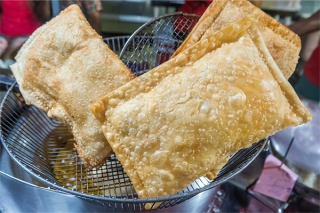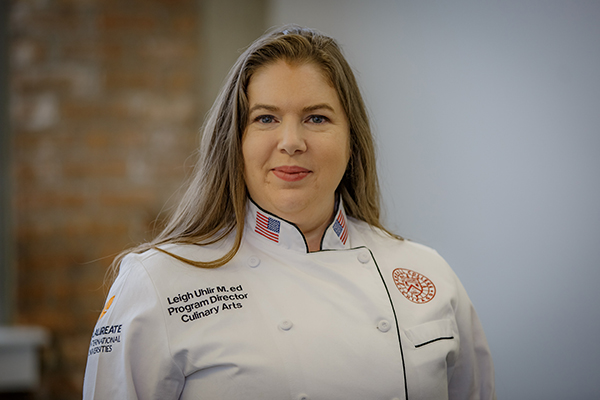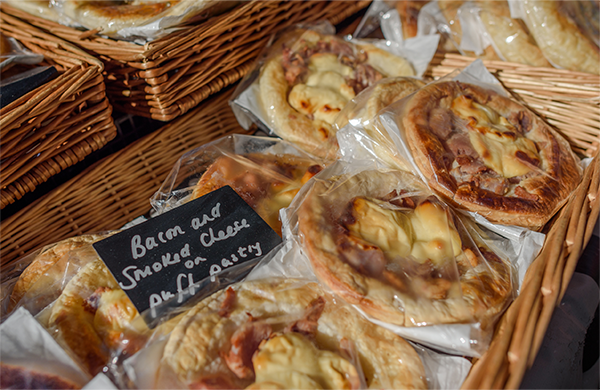
Portable Pastries Make Meals
01 October 2024Opportunities for bakers to help hungry consumers craving hearty meals.
By Lisa Parrish, GMC Editor
Feedback & comments: This email address is being protected from spambots. You need JavaScript enabled to view it.
It is hard to pin down an exact definition of a handheld bakery item. If an empanada is a portable baked pastry, would you consider a super-sized calzone to be the same? How about a rectangular deep-fried flakey Brazilian pastel, which is considered street food despite its size? To narrow the field, let’s focus on handheld stuffed and sealed pastry items meant for a meal replacement and not just a snack. The kind of quick food consumers can pick up during their unrelenting, busy days.
People with hectic schedules are eating away from home more often than they eat at home. The slow, isolated days of COVID feel long ago and a thing of the past. Today, Americans spend more than 55 percent of their food budget on items eaten out of the house. Let’s explore this bakery area of handheld portable items available across multiple dayparts that fit into schedules that find people hungry and not at home.
During COVID, consumers turned to nostalgic food and perhaps this is one of the last remaining pandemic vestiges – a love of things gone by. A handmade portable bakery item can evoke memories of being presented with a flavorful baked pastry, wrapped in wax paper or something unceremoniously dropped into a paper bag, and taking it a few steps away just to unwrap the corner or dig down to find the delicious made-to-order item. Consumers are still looking for that handmade, hand-held meal, but with updated flavors and textures and a stuffing that satisfies today’s cravings and hunger.
Let’s get into how this popular-through-the-ages handheld bakery item is put together nowadays and how it answers consumers’ calls for delicious meals on the go.
Dough
Examples of doughs in this category include laminated, cut-in, puffed or yeasted. Each dough type will affect the item’s texture and appearance. However, the one aspect that each of these handheld doughs has in common is the baker’s ratio of 50 percent fat, according to Heidi Hedeker, associate professor at Kendall College at National Louis University’s School of Baking & Pastry. “These doughs make the most successful handheld items.” Portable baked doughs are often rich and tender with a smooth crumb.
Cooking methods
There are many cooking methods utilized in cooking bakery items for people on the go, including frying, steaming and baking to name a few.
Frying submerges the pastry in hot oil and cooks the outside to a crisp while leaving the interior chewy and tender, which is perfect for both savory and sweet fillings. Also, Hedeker notes that the shelf life of a fried item is limited and it is designed to be eaten right away. Examples of fried and filled handheld items include samosas, empanadas and Brazilian pastels.
Steaming is a method that creates a soft exterior without browning and is often used for doughs with high moisture content or fillings that require gentle cooking. This method is best for soft yeast-based doughs such as baozi, manapua or soup dumplings.
Baking may be the most common cooking method and results in a crispy or golden exterior. Baked pastries have a longer shelf life and may include items such as hand pies, calzones, and turnovers such as Jamaican patties.
 Fillings from sweet to exploding savory options
Fillings from sweet to exploding savory options
There are endless options for both sweet- and savory-filled handhelds. However, the influence of global cuisine is driving a rise in savory options. For example, Latin American empanadas, Indian samosas and Jamaican patties are filled with meat, potatoes, lentils and cooked with regional spices and are very popular handheld options. In fact, empanadas were the eighth most-ordered item according to GrubHub’s “Slate of the Plate” in 2021.
Although sweet-filled pastries are widely available, when consumers searching for a meal replacement that will carry them for several hours to their next eating opportunity, these items may not be hearty enough. And finally, savory baked items are viewed by consumers as healthier options.
However, when a baked item with a sweet filling is selected, gone by the wayside are the sugar bombs that leave a consumer reeling from the effects of their blood sugar spike and crash. Today, sweet fillings make use of fruit vinegar to increase acidity levels. “The acidity also creates a tangy and bright taste,” according to Hedeker. She also suggests that pickled fruits, such as pickled blueberries, be added to cream cheese to help bridge the sweetness with acidity.
Conclusion
While sweet-filled pastries remain popular, particularly as breakfast and dessert options, savory items are growing faster because consumers require convenient meal replacements that include a diversity of flavors. This shift suggests a growing opportunity for bakeries to expand their savory offerings and satisfy busy consumers until their next meal.
